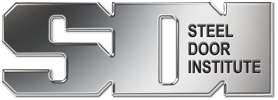Maintenance of Steel Door and Frame Assemblies
SDI 124-22
View PDF
1. Introduction
This document is intended to serve as a general outline of maintenance activities needed for standard steel doors and frames. Maintenance will be, for the most part, associated with the accessories and hardware attached to the door and frame.
Maintenance of any product is important and necessary to obtain the maximum benefits of product service and longevity. Steel door and frame assemblies are not different. In fact, in some cases where the door and frame assembly is used as a “fire rated” barrier or a “leakage rated” smoke barrier, proper maintenance is crucial. Basic maintenance to ensure the proper functioning of the assembly is imperative and well worth the effort to provide for human life safety.
2. Areas to be inspected
The following items should be periodically checked. The frequency with which these checks are performed must be established at the discretion of the building owner, insurance company, labeling authority (as applicable), and maintenance service. Since doors in different areas of a building access service different traffic, the frequency of periodic inspections would occur respectively.
Hinges
- Check all hinges for loose attaching screws, hinge pin wear or other notable defects. Service the hinges or remove defective parts and replace per the manufacturer’s recommendations. The door should always swing freely and smoothly without obstruction from the opened to latched (when latching device is used) position.
Locksets, panic devices, fire exit hardware
- Check all locksets for loose attaching screws, latch wear or other notable defects. Service the lockset or remove defective parts and replace per the manufacturer’s recommendations. The door should always latch freely and smoothly without obstruction. Self-latching devices should always function freely and smoothly as the door swings into the closed position. Additional force should not be needed to achieve latching. Silencers (mutes) should be replaced when latch operation is compromised by wear.
Strike plate
- The strike plate should be firmly attached to the frame or inactive leaf of a pair of doors. Check for loose screws and/or other notable defects. Service or remove and replace per the manufacturer’s instructions.
Closing devices
- Check all closing devices for loose attaching screws, linkage arm and pin wear, fluid leakage or other notable defects. Service the device or remove defective parts and replace following the manufacturer’s recommendations. The primary and secondary closing speed adjustments should also be set and maintained in accordance with the manufacturer’s recommendations. The device should allow the door to operate freely and smoothly throughout its entire swing range and positively latch (if so equipped) or remain in the closed position.
Flush bolts
- Check all flush bolts for loose attaching screws, rod bolt adjustment and strike plate (on both door and frame if so equipped) attachment. Service the devices or remove defective parts and replace following the manufacturer’s recommendations. The rod bolts should retract, extend and engauge the strike or keeper hole freely and smoothly for both manual and/or automatic flush bolts.
Glass lights
- The glazing material should be checked for cracks and/or missing pieces of glazing. The glazing mounting frame should be checked to assure all attaching screws (if used) are tight and the unit is securely attached to the door. Service the glass light or remove defective parts and replace by following the manufacturer’s recommendations. Also be sure to use approved safety glass in appropriate applications/locations, or fire-rated glass and glazing in fire doors, windows or lights.
Door and frame finish
- A general visual inspection of the door and frame finish should be periodically conducted. Any excessive finish defects should be repaired and repainted. Adequate protection is needed to help prevent the product from rusting prematurely and shortening its service life. Certification labels present shall not be painted over during any repainting.
Fire door/smoke door assemblies
- Fire-rated and/or smoke control assemblies are specified and installed to meet “safety to life code requirements.” It is imperative that these assemblies receive regularly scheduled maintenance checks for all of the above items. Additionally, for the assembly to serve its purpose of stopping fire and/or smoke propagation it must function freely with the ability to positively latch in the closed position. Therefore, propping or blocking these doors in an open position is in violation of intended use and purpose as established in building codes. These doors must not be obstructed in any fashion preventing them from functioning as intended.
Gasketing/weatherstripping
- A visual and operational inspection is periodically necessary for gasketed or weatherstripped areas such as perimeter seals, threshold seals, door bottoms, silencers, mutes, etc. Inspect for signs of deterioration such as splitting, cracking or deforming of flexible components. Install replacement components as needed.
- To inspect operational integrity, position gasketing to create proper contact along the door’s entire perimeter. The test for proper contact is usually done with common paper. The paper should be firmly held in place by inserting it between the door and gasket and then closing the door. If the paper is not firmly held in place, the seal is inadequate. The paper test should be conducted along the entire perimeter.
Related Documents
— NFPA 80 Standard for Fire Doors and Other Opening Protectives, Chapter 5
— NFPA 105 Standard for Smoke Door Assemblies and Other Protective Openings
— SDI-122 Installation and Troubleshooting Guide for Standard Steel Doors and Frames
